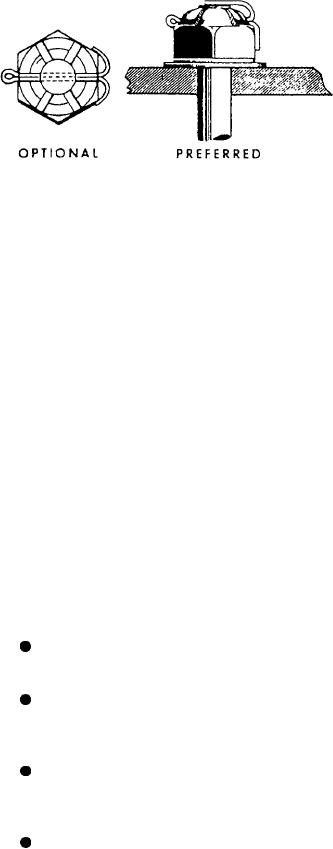
safety wired to each other in a series rather than
individually. The number of nuts, bolts, or screws
that may be safety wired together depends on the
application. For instance, when you are safety
wiring widely spaced bolts by the double-twist
method, a group of three should be the maximum
number in a series.
When you are safety wiring closely spaced
bolts, the number that can be safety wired by a
24-inch length of wire is the maximum in a series.
The wire is arranged in such a manner that if the
Figure 2-26.-Cotter pin installations.
bolt or screw begins to loosen, the force applied
to the wire is in the tightening direction.
When you use the safety wire method of
Cotter Pins
safetying, follow these general rules:
Use cotter pins to secure bolts, screws, nuts,
1. Torque all parts to the recommended
and pins. Some cotter pins are made of low-
values, and align holes before you attempt to
carbon steel, while others consist of stainless steel
and thus are more resistant to corrosion. Use
proceed with the safetying operation. Never over-
stainless steel cotter pins in locations where non-
torque or loosen a torqued nut to align safety wire
holes.
magnetic material is required. Regardless of shape
2. The safety wire must be new upon each
or material, use all cotter pins for the same general
purpose-- safetying.
application.
3. When you secure castellated nuts with
NOTE: Whenever uneven-prong cotter
safety wire, tighten the nut to the low side of the
pins are used, the length measurement is
selected torque range unless otherwise specified.
If necessary, continue tightening until a slot aligns
to the end of the shorter prong.
with the hole.
4. All safety wires must be tight after
Cotter pin installation is shown in figure 2-26.
Use castellated nuts with bolts that have been
installation but not under such tension that
normal handling or vibration will break the wire.
drilled for cotter pins. Use stainless steel cotter
pins. The cotter pin should fit neatly into the hole,
5. Apply the wire so that all pull exerted by
with very little side-play. The following general
the wire tends to tighten the nut.
rules apply to cotter-pin safetying:
6. Twists should be tight and even, and the
wire between the nuts should be as taut as
possible without being overtwisted.
Do not bend the prong over the bolt end
7. A pigtail of 1/4 to 1/2 inch (three to six
beyond the bolt diameter. (Cut it off if necessary.)
twists) should be made at the end of the wiring.
This pigtail must be bent back or under to prevent
Do not bend the prong down against the
surface of the washer. (Again, cut it off if
it from becoming a snag.
necessary.)
Safety wire comes in different sizes and
Do not extend the prongs outward from
material. Use the size and material appropriate
the sides of the nut if you use the optional
for the job. When using the single-wire method,
wraparound method.
you should use the largest size wire that the hole
will accommodate. Different types of safety wire
include Monel for normal use, Inconel for high
Bend all prongs over a reasonable radius.
Sharp angled bends invite breakage. Tap the
temperatures (800- 1500 degrees), and alclad for
prongs lightly with a mallet to bend them.
nonmagnetic applications.
2-19

